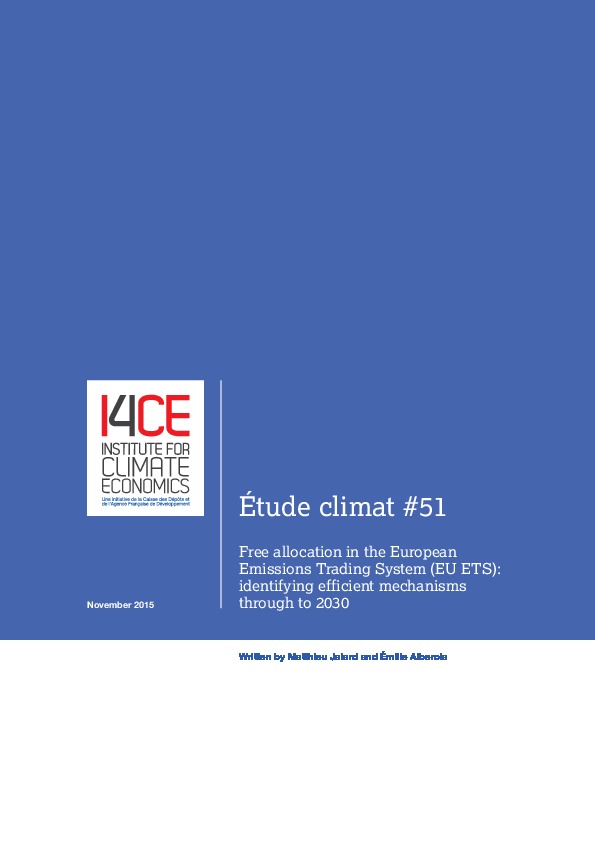Climate Report No.51: FREE ALLOCATION IN THE EUROPEAN EMISSIONS TRADING SYSTEM (EU ETS): IDENTIFYING EFFICIENT MECHANISMS THROUGH TO 2030
In a world with asymmetrical climate policies, the conclusions of the European Council of October 2014 agreed on continuing the allocation of free CO2 emissions allowances beyond 2020 to industrial sectors in the EU ETS. This statement has been confirmed in the European Commission’s proposal to revise EU ETS directive for phase IV disclosed in July 2015. The stated objective is to ensure that the most efficient industrial installations do not face undue carbon costs which would lead to carbon leakages. Furthermore, free allocations should not undermine the incentive to cut CO2 emissions, lead to distortions or windfall profits and reduce the auctioning share of allowances.
From 2013 to 2020, the allocation of free allowances has been defined according to harmonized European rules based on benchmarks (carbon intensity targets) and historical output adjusted to the free allocation cap by applying the Cross-Sectoral Correction Factor (CSCF). What would be the impact of pursuing the current mechanism through to 2030? Does the EU Commissions’ proposal of 15th July respond to the Council’s requirements? Which alternative mechanisms could do so?
This study examines four scenarios and their potential consequences.
- Scenario 1 continues the current free allocation mechanism until 2030. The volume of free allocations thus calculated would be higher than the available free allocation cap and would need to be reduced by a Cross-Sectoral Correction Factor (CSCF) of 66% in 2030. Carbon costs would thus increase for all installations, regardless their exposure to carbon leakages, reducing the protection of most exposed sectors, while widely allocating sectors with limited exposure.
- Scenario 2 analyses the proposal to implement an allocation mechanism based on recent industrial output combined with appropriate updating of benchmarks. This allocation method is more effective in combating carbon leakage, as it gives clearer incentive to maintain domestic production. Besides, it enables to avoid over-allocations and perverse threshold effects observed in Phase III, but it further mutes the carbon price signal to consumers, and should be complemented by additional mechanisms to exploit demand -side abatement potentials. This mechanism would lead to a less impacting CSCF of 71% in 2030 with a 1.4% annual growth assumption that would however depend on the aggregate output level. Based on our estimates, this factor would be comprised between 62% and 82% in 2030, entailing an uncertainty about the net carbon cost borne by installations amounting to 10% of added value for the cement sector and 6% for the steel sector, with a 30€/tCO2 price assumption.
- In Scenario 3, a more targeted and focused allocation is presented, which better reflects the exposure to carbon leakage risks. It is proposed to use differentiated allocation rates either based on carbon cost and trade intensity thresholds like implemented in California for example, or based on targeted maximum carbon costs for each sectors depending on trade intensity. This would enable to reduce the allocation volume and overcome the ex post correction and the uncertainty coming with it, and to mitigate carbon costs more efficiently for exposed sectors.
- The Scenario 4 assesses the European Commission’s proposal, which could be leading to a 20% ex post reduction of allocation volume to all installations by 2030, on top of the 20% uniform reduction of benchmarks. Focusing allocation to exposed sectors, and enhancing flexibility in the supply of free allowances through a dynamic New Entrant Reserve could be levers to help combat carbon leakages more efficiently and maintain incentives to reduce emissions.
In the end, it appears that a combination of instruments is needed to forge a credible roadmap for decarbonisation of industry sectors: a predictable carbon price signal, flexible and targeted free allocation, as well as additional instruments to steer demand for low-carbon products and the emergence of innovative production processes.
